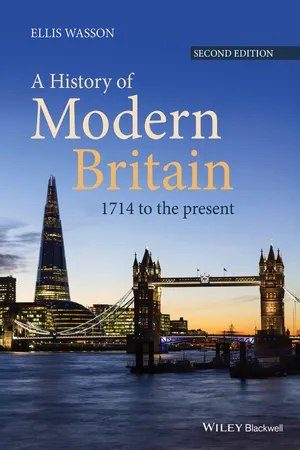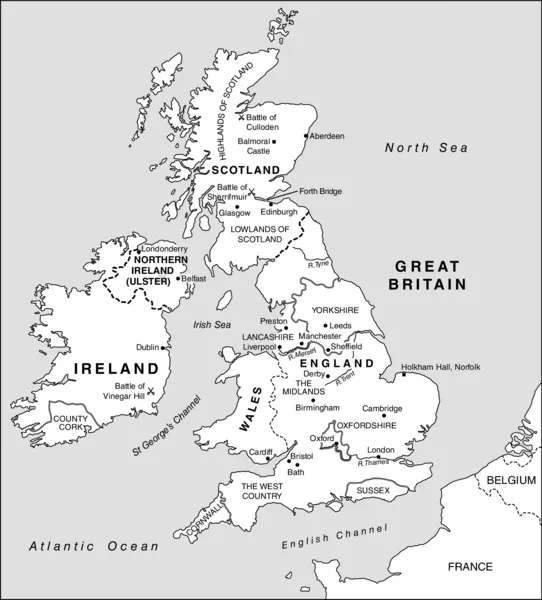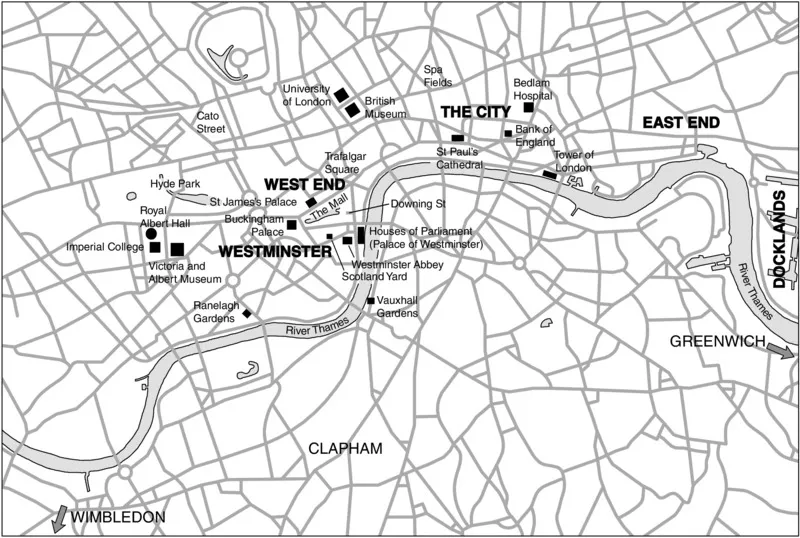
- English
- ePUB (mobile friendly)
- Available on iOS & Android
eBook - ePub
About this book
Now available in a fully-revised and updated second edition, A History of Modern Britain: 1714 to the Present provides a comprehensive survey of the social, political, economic and cultural history of Great Britain from the Hanoverian succession to the present day.
- Places Britain in a global context, charting the rise and fall of the British empire and the influence of imperialism on the social, economic, and political developments of the home country
- Includes revised sections on imperialism and the industrial revolution that have been updated to reflect recent scholarship, a more reflective view on New Labour since its demise, and an all new section on the performance of the Conservative – Lib/Dem coalition that came into office in 2010
- Features illustrations, maps, an up-to-date bibliography, a full list of Prime Ministers, a genealogy of the royal family, and a comprehensive glossary explaining uniquely British terms, acronyms, and famous figures
- Spans topics as diverse as the slave trade, the novels of Charles Dickens, the Irish Potato Famine, the legalization of homosexuality, coalmines in South Wales, Antarctic exploration, and the invention of the computer
- Includes extensive reference to historiography
Frequently asked questions
Yes, you can cancel anytime from the Subscription tab in your account settings on the Perlego website. Your subscription will stay active until the end of your current billing period. Learn how to cancel your subscription.
No, books cannot be downloaded as external files, such as PDFs, for use outside of Perlego. However, you can download books within the Perlego app for offline reading on mobile or tablet. Learn more here.
Perlego offers two plans: Essential and Complete
- Essential is ideal for learners and professionals who enjoy exploring a wide range of subjects. Access the Essential Library with 800,000+ trusted titles and best-sellers across business, personal growth, and the humanities. Includes unlimited reading time and Standard Read Aloud voice.
- Complete: Perfect for advanced learners and researchers needing full, unrestricted access. Unlock 1.4M+ books across hundreds of subjects, including academic and specialized titles. The Complete Plan also includes advanced features like Premium Read Aloud and Research Assistant.
We are an online textbook subscription service, where you can get access to an entire online library for less than the price of a single book per month. With over 1 million books across 1000+ topics, we’ve got you covered! Learn more here.
Look out for the read-aloud symbol on your next book to see if you can listen to it. The read-aloud tool reads text aloud for you, highlighting the text as it is being read. You can pause it, speed it up and slow it down. Learn more here.
Yes! You can use the Perlego app on both iOS or Android devices to read anytime, anywhere — even offline. Perfect for commutes or when you’re on the go.
Please note we cannot support devices running on iOS 13 and Android 7 or earlier. Learn more about using the app.
Please note we cannot support devices running on iOS 13 and Android 7 or earlier. Learn more about using the app.
Yes, you can access A History of Modern Britain by Ellis Wasson in PDF and/or ePUB format, as well as other popular books in History & 19th Century History. We have over one million books available in our catalogue for you to explore.
Information
Part I
Uniting the Kingdoms
CHAPTER 1
The British Isles in 1714
History is about change. Rises and falls come naturally to peoples and states. Wars and revolutions have convulsed the modern world. Britain was not isolated from these events and was often a prime actor in them. Big changes place enormous stress on societies, and only those that have powerful and resilient cores survive rapid innovation or decline without losing their balance. Strong institutions and deep traditions allow countries to transform themselves without extreme breaks with the past that usually end in disorientation and great suffering. Britain is the only major European state not to have had a revolution in the last three centuries. Most of its neighbors have undergone traumatic episodes that have produced terrible self-inflicted wounds under the rule of tyrants who rejected the constraints of law and morality that protect us from the abuse of power. Britain has been a center of innovation and change in the modern world but also stable and peaceful. Patterns of behavior, attitudes of mind, conditions of living, and seemingly anachronistic institutions have persisted over the centuries at all levels of society. Some argue these continuities have caused a kind of societal constipation, making it harder for the country to achieve a fair distribution of healthcare, education, and wealth. On the other hand, Britain was spared the Terror, gulags, and the Holocaust.
Before we begin to look at the narrative of British history over the last three centuries we need first to study the underpinnings: the geography, the economy, the social order, religion, and ways of life. Here lie the origins of stability and the engines that drive change. Over time these forces helped shape national identity, the class structure, and empire.
Geography and History
Remember above all else that Great Britain and Ireland are islands (see Map 1.6). The archipelago which they form off the northwest coast of Europe is separated from the Continent by a narrow channel that is often unpleasantly rough. Once, an heir to the English crown drowned in it, and a large modern ferry sank without a trace during a storm in the Irish Sea as recently as 1953. Northerly winds driving the Atlantic into the shallow and confined waters of the North Sea create huge waves that can make it dangerous to venture out of port. Over the last thousand years mainland armies intent on invasion have only succeeded in making the crossing to England twice. A threat always lingered that Spain, France, or Germany might land men or arms on the remote west coast of Ireland where only seals stood guard. Britain was vulnerable to attack from the rear. Ireland's tragic fate was that England came to associate oppression in Dublin with safety at home. Living as islanders with sharply defined borders intensified a sense of being distinctive peoples in both Britain and Ireland.
The second most important fact to remember about the archipelago is the fortunate proximity of the Gulf Stream, a warm current originating in the tropical Caribbean that flows northeastwards across the Atlantic passing close to the southern and western coasts of England and Ireland. Palm trees can be seen in Cornwall and Cork, and the general climate is so mild that pipes were often attached to exterior walls when modern plumbing came to be installed in old buildings because there was little chance of sustained deep freezes during the winter. Aside from the mountainous areas in Wales and Scotland and some of the higher elevations in northern England snow is comparatively rare and usually disappears quickly. Even though the islands lie in the same latitude as Labrador, Britain and Ireland are encased in a thermos-like oceanic environment that keeps the weather cool in summer and temperate in winter. Winds from the Atlantic push a steady flow of rain across the islands, which makes drought infrequent.

Map 1.1 British Isles
The third striking characteristic of the archipelago relates to size. Britain is tiny compared to Russia. England is half the area of the Italian peninsula and one-fourth that of France and could be fitted within the borders of a number of US states. Once roads had been surfaced with durable materials in the eighteenth century and railroads were built in the nineteenth, people and goods could move and be moved around the place with remarkable rapidity. Almost all the important population centers came to be connected by trips of a few hours. Even northern Scotland could be reached from London in less than a day. No one lives more than 70 miles from the sea. Once outside London visitors from North America often feel they have tumbled into Lilliput. Edinburgh and Dublin seem like miniaturized versions of what one expects capital cities to be. In the countryside, narrow lanes linking quaint villages well protected from urban sprawl with names such as Lower Slaughter and Steeple Bumpstead lead one into a world that even today appears taken from a storybook. Rivers are small in Britain, but there are many of them. They are often navigable for lengthy stretches, and provided a natural system of transportation for heavy goods that eased the movement of food and manufactured items even before the water courses were connected by a man-made network of canals.
The feel of a miniature world can be misleading. Forty years ago, before the decline in industrial output became precipitate, a train journey between Manchester and Sheffield impressed on the traveler the giant scale of what was once the workshop of the world. The sea entrance into the ship channel of the port of Liverpool, now largely abandoned but once the center of the Atlantic passenger and cargo trade, still conveys the impression of penetrating a nodal point on the globe. The Scottish Highlands remain one of the most awe-inspiring landscapes in Europe. London (see Map 1.7) exudes the feel of an imperial city, vast in size, with some of the most grandiose and elaborate royal and civic architecture in Europe. It has no single building to match the Forbidden City of Beijing or the ensemble of structures found along the Mall in Washington, but the sum of museums, palaces, concert halls, processional routes, riverscapes, churches, government offices, and cascade of suburbs is unique. Dotted around the countryside in all parts of the archipelago is a remarkable collection of medieval cathedrals, lovely market towns, splendid regional capitals, and enormous aristocratic palaces surrounded by far-flung walls and thickly timbered parks that have no equal in their numbers, continuity of ownership, and beauty, anywhere.
If being an island has been central to the development of England, the greatest single fact in the histories of Ireland, Scotland, and Wales was their proximity to England. Four distinct peoples inhabited various parts of the archipelago. They in turn encompassed numerous further divisions and fragments. The Highland Scots were very different from their brethren in the Lowlands; Cornwall, a peninsula at the southwestern tip of England, had distinctive traditions and even its own language; before 1922 Ireland was ruled by a Protestant elite largely recruited from Scotland and England, while the native population was Roman Catholic among whom Gaelic speakers were once predominant. The diversity of peoples and cultures within the confines of such a small physical capsule makes it hard to write a single narrative about their development over the last three centuries. The relative size of England skews our perspective. There is no doubt that it was a Goliath among a much smaller and weaker collection of entities. Yet, a Scottish army invaded England in 1640, and subsequent incursions reached deep into the south in 1715 and 1745. The English repeatedly suppressed rebellions in Ireland that threatened, or at least were imagined to be the harbingers of, mortal danger.

Map 1.2 London
The royal family of Scotland, the Stuart dynasty (spelled Stewart in Scotland), inherited the English throne in 1603 and ruled jointly over the two countries, although increasingly this proved to be like having one leg each on the backs of two unharnessed horses. A constitutional merger took place in 1707, which opened up a golden age of economic and intellectual expansion for the smaller partner. On the other hand, the fragile Union between Ireland and Britain, concluded in 1801, never “took.”
Much of the time the smaller nations were required to cooperate only at a grand strategic level, leaving the decisions of everyday life largely to local governors. Nevertheless, the overwhelming nature of English prosperity and its eventual global hegemony had a subtle, undirected homogenizing force that gradually drew the disparate cultures closer and closer together. The Welsh preserved their own language, though most of them eventually came to speak English as well, while Cornish died out and Irish and Scottish Gaelic have largely disappeared. The English were glad to see traditions that encouraged independence evaporate and sporadically attempted to stamp them out, but, in the case of native languages, for example, the gravest danger to survival was not London-inspired campaigns to eradicate difference. English was so convenient and valuable to learn that its adoption became impossible to halt. People voted with their tongues.
The physical geography of the British Isles shaped the direction that events took and channeled economic, social, and political forces. Britain was thrust into the Atlantic as a launching pad for seaborne exploration, trade, and empire. The rich seams of coal and iron ore, the navigable waterways, the abundance of ports, and the location of the islands are fundamental to this story.
Readers also must keep in mind “negative space” in the historical record that arises from geography, the things that did not happen because of the physical environment. Fo...
Table of contents
- Cover
- Title page
- Copyright
- Dedication
- Preface
- Acknowledgments
- Part I Uniting the Kingdoms
- Part II The British Century
- Part III Dividing the Kingdoms
- Chronology
- Glossary
- Bibliography
- Prime Ministers
- Genealogy of the Royal Family
- Index
- EULA